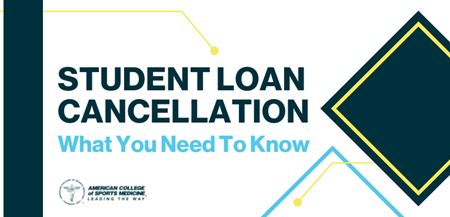Gretchen Patch, MPH, CPH |
Sept.
21, 2022
 In August, President Biden announced that many federal student loan borrowers would be eligible for loan cancellation. While more details on implementation are expected in the coming weeks, here’s what we know now.
In August, President Biden announced that many federal student loan borrowers would be eligible for loan cancellation. While more details on implementation are expected in the coming weeks, here’s what we know now.
Borrowers making less than $125,000 per year individually or $250,000 per year for married couples are eligible to have up to $10,000 in student loans cancelled. Borrowers that received a Pell Grant as part of their student aid package are eligible for up to $20,000 in cancellation.
All loans must be federal student loans to qualify, including subsidized and unsubsidized Direct loans, Parent Plus loans and graduate school loans. Private student loans aren’t eligible for cancellation. There is no employment requirement or minimum number of payments required to receive this student loan cancellation.
To get cancellation, you’ll need to submit an online application, expected to launch in October. Sign up here to receive email updates when the form is ready online. Loans are expected to be cancelled within 4-6 weeks of application. Applying by Nov. 15, 2022, should ensure that your loans are cancelled and any remaining balance re-amortized before loan payments resume in 2023.
If you’re one of the 9 million people who made payments during the pandemic forbearance (March 2020 to Dec. 31, 2022), you can request a refund for those payments and then apply for student loan cancellation. Contact your loan servicer to request a refund.
Visit studentaid.gov to check your loan balances, find your loan server, update your contact information and see if you were a Pell Grant recipient.
PSLF 2.0 — It’s worth a second look
If you expect to still have a loan balance after receiving the cancellation described above, consider the Public Service Loan Forgiveness (PSLF) program. We’ve all heard the struggles of the PSLF program over the past 10+ years. I’m here to tell you to ignore what you’ve heard. Recent changes to the PSLF program have temporarily expanded eligibility to qualify for loan forgiveness; however, this opportunity ends Oct. 31, 2022 so act quickly.
Some of the basic requirements remain the same — you have to be working full time in public service (nonprofit, government, public universities, etc.) for a qualifying employer and have made 120 payments on your Direct Loans or Direct Consolidation Loans.
The most important temporary change now credits payments that previously didn’t count toward the required 120 payments. This includes payments made on a variety of federal student loan types, payments under any repayment plan, late payments and more. Additionally, forbearance periods and economic hardship deferment may also be credited toward your total payment count, including the pandemic forbearance period. Periods of default and in-school deferment still don’t qualify.
Even if you haven’t qualified for PSLF before, it’s worth your time to explore the temporary eligibility expansion and see if you qualify for loan forgiveness, but you must act now before the expansion expires.
Tips for PSLF success
I personally went through the PSLF process a few years ago after completing all of the requirements for the original eligibility. While it was a difficult process then, the lessons I learned can help you with today’s PSLF.
-
Read all the details. The PSLF website has a lot of information, and it can seem overwhelming. Read it anyway.
-
Follow the instructions exactly. There have been stories of people getting rejected for not following the date format or something equally miniscule. Don’t let that be your story.
-
Get hand-written signatures, not digital signatures.
-
Be a squeaky wheel and your own advocate. If you call your loan servicer and you’re not getting the information or progress you need, ask for a supervisor firmly and politely. You may need to ask more than once.
-
If you run into a roadblock, ask your loan servicer if there’s an escalation team that can review your account to clarify which payments qualify.
-
Keep meticulous notes through every step. Note who you talk to, when, what they said, and any steps or dates they give you.
Gretchen Patch, MPH, CPH, is ACSM's Senior Director of Strategic Health Initiatives and Partnerships. Her public health expertise has guided the ACSM American Fitness Index report since 2018 and helped to lead ACSM's strategy to protect its staff and members throughout the pandemic.